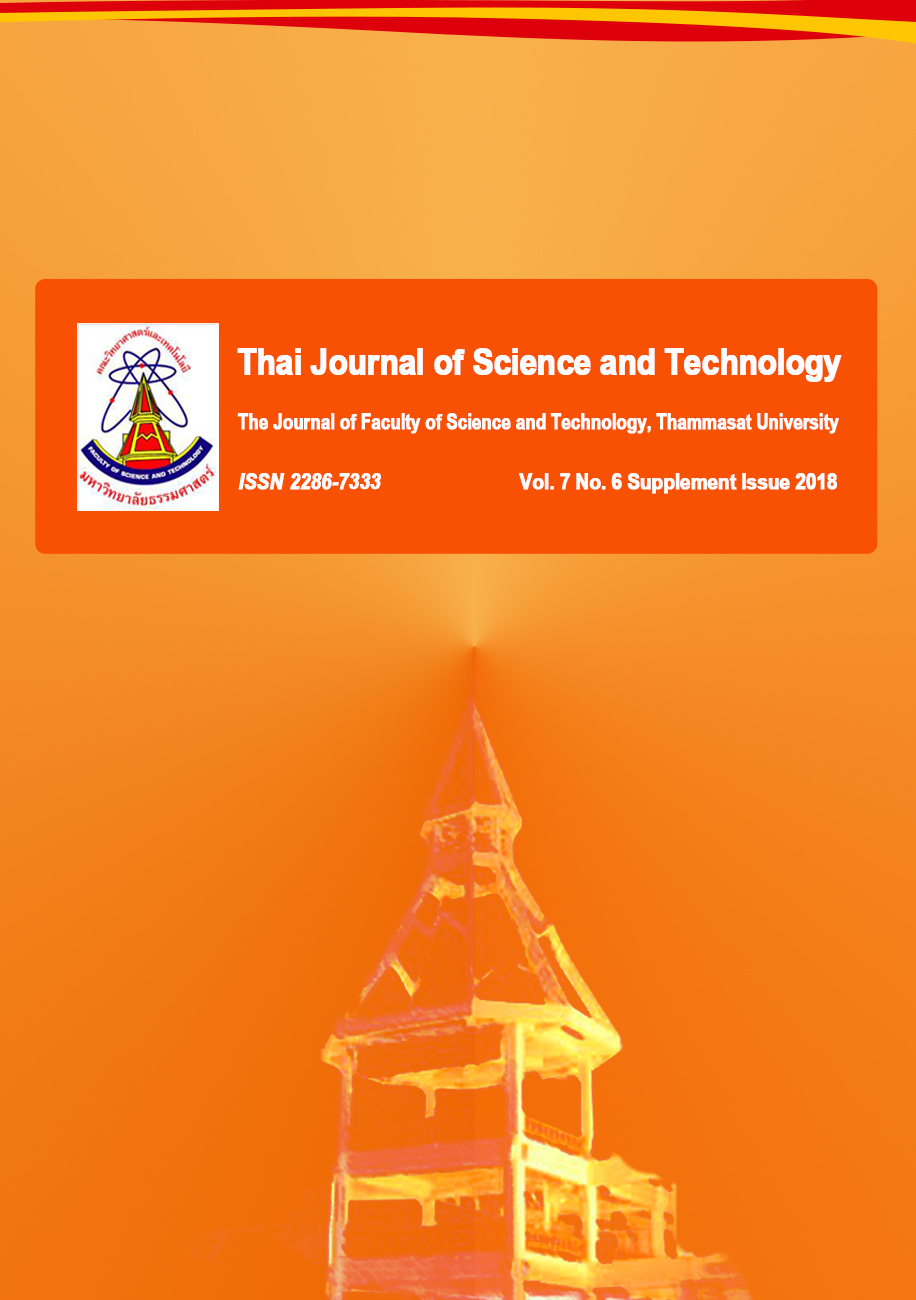เฮลิโคแบคเตอร์ ไพโลไร รูปร่างทรงกลม ซึ่งมีชีวิต แต่ไม่เจริญเติบโต ยังคงสร้างกลูตามิลทรานส์เพปทิเดสที่เป็นปัจจัยก่อความรุนแรงโรค
Main Article Content
Abstract
Abstract
Helicobacter pylori usually presents in a spiral-shape, but in a stress condition, it adapts to a coccoid form which is viable but non-culturable (VBNC). Previous studies reported that the VBNC coccoids still produce mRNAs of some virulence factors. g-Glutamyl transpeptidase (GGT) is an enzyme involving in the bacterial colonization and has not been studied in the coccoid form of the bacteria. This study aims to investigate the expression of ggt gene of the coccoids. The spiral H. pylori required low level of oxygen was transformed into the coccoid form by an exposure to the ambient oxygen for a period of time and the transcriptional level of the coccoid ggt gene was compared to that of the spiral bacteria. After 9 hours of the oxygen exposure, it was observed that the spiral-shape bacteria changed into the full coccoids and continuously expressed ggt mRNA. It revealed that even in the VBNC coccoid form, the H. pylori still produce its virulence factor that is important for the bacterial colonization. This situation can occur when the bacteria are accidentally contaminated to the environment and, therefore, the bacterial infection would be critically uncontrollable.
Keywords: Helicobacter pylori; gamma-glutamyl transpeptidase; coccoid
Article Details
บทความที่ได้รับการตีพิมพ์เป็นลิขสิทธิ์ของคณะวิทยาศาสตร์และเทคโนโลยี มหาวิทยาลัยธรรมศาสตร์ ข้อความที่ปรากฏในแต่ละเรื่องของวารสารเล่มนี้เป็นเพียงความเห็นส่วนตัวของผู้เขียน ไม่มีความเกี่ยวข้องกับคณะวิทยาศาสตร์และเทคโนโลยี หรือคณาจารย์ท่านอื่นในมหาวิทยาลัยธรรมศาสตร์ ผู้เขียนต้องยืนยันว่าความรับผิดชอบต่อทุกข้อความที่นำเสนอไว้ในบทความของตน หากมีข้อผิดพลาดหรือความไม่ถูกต้องใด ๆ
References
Chevalier, C., Thiberge, J., Ferrero, R.L. and Labigne, A., 1999, Essential role of Helicobacter pylori γ-glutamyl transpeptidase for the colonization of the gastric mucosa of mice, Mol. Microbiol. 31: 1359-1372.
Chomczynski, P. and Sacchi, N., 1987, Single step method of RNA isolation by acid guanidinium thiocyanate-phenol-chloroform extraction, Anal. Biochem. 162: 156-159.
Cover, T.L., 2016, Helicobacter pylori diversity and gastric cancer risk, MBio 7(1): e01869-15.
Donelli, G., Matarrese, P., Fiorentini, C., Dainelli, B., Taraborelli, T., Campli, E., Bartolomeo, S. and Cellini, L., 1998, The effect of oxygen on the growth and cell morphology of Helicobacter pylori, FEMS Microbiol. Lett. 168: 9-15.
Leduc, D., Gallaud, J., Stingl, K. and de Reuse, H., 2010, Coupled amino acid deamidase-transport systems essential for Helicobacter pylori colonization, Infect Immun. 78: 2782-2792.
Monstein, H.J. and Jonasson, J., 2001, Differen-tial virulence-gene mRNA expression in coccoid forms of Helicobacter pylori, Biochem. Biophys. Res. Commun. 285: 530-536.
Nilsson, H.O., Blom, J., Al-Soud, W.A., Ljungh, A., Andersen, L.P. and Wadstrom, T., 2002, Effect of cold starvation, acid stress, and nutrients on metabolic activity of Helicobacter pylori, Appl. Environ. Microbiol. 68: 11-19.
Obonyo, M., Zhang, L., Thamphiwatana, S., Pornpattananangkul, D., Fu, V. and Zhang, L., 2012, Antibacterial activities of liposomal linolenic acids against antibiotic-resistant Helicobacter pylori, Mol. Pharm. 9: 2677-2685.
Pfaffl, M.W., 2001, A new mathematical model for relative quantification in real-time RT-PCR, Nucl. Acids Res. 29: e45.
Poursina, F., Faghri, J., Moghim, S., Zarkesh-Esfahani, H., Nasr-Esfahani, B., Fazeli, H., Hasanzadeh, A.V. and Safaei, H.G., 2013, Assessment of cagE and babA mRNA expression during morphological conversion of Helicobacter pylori from spiral to coccoid, Curr. Microbiol. 66: 406-413.
Shao, C., Sun, Y., Wang, N., Yu, H., Zhou, Y., Chen, C. and Jia, J., 2013, Changes of proteome components of Helicobacter pylori biofilms induced by serum starvation, Mol. Med. Rep. 8: 1761-1766.
She, F.F., Lin, J.Y., Liu, J.Y., Huang, C. and Su, D.H., 2003, Virulence of water-induced coccoid Helicobacter pylori and its experimental infection in mice, World J. Gastroenterol. 9: 516-520.
Shibayama, K., Wachino, J., Arakawa, Y., Saidijam, M., Rutherford, N.G. and Henderson, P.J., 2007, Metabolism of glutamine and glutathione via gamma-glutamyltranspeptidase and glutamate transport in Helicobacter pylori: Possible significance in the pathophysiology of the organism, Mol. Microbiol. 64: 396-406.
Sisto, F., Brenciaglia, M.I., Scaltrito, M.M. and Dubini, F., 2000, Helicobacter pylori: ureA, cagA and vacA expression during conversion to the coccoid form, Int. J. Antimicrob. Agents 15: 277-282.
Stark, R.M., Suleiman, M.S., Hassan, I.J., Greenman, J. and Millar, M.R., 1997, Amino acid utilization and deamination of glutamine and asparagine by Helicobacter pylori, J. Med. Microbiol. 46: 793-800.
Roger-Broadway, K.R. and Karteris, E., 2015, Amplification efficiency and thermal stability of qPCR instrumentation: Current landscape and future perspectives, Exp. Ther. Med. 10: 1261-1264.
Romano, M., Ricci, V. and Zarrilli, R., 2006, Mechanisms of disease: Helicobacter pylori-related gastric carcinogenesis implications for chemoprevention, Nat. Clin. Pract. Gastroenterol. Hepatol. 3: 622-632.
Tominaga, K., Hamasaki, N., Watanabe, T., Uchida, T., Fujiwara, Y., Takaishi, O., Higuchi, K., Arakawa, T., Ishii, E., Kobayashi, K., Yano, I. and Kuroki, T., 1999, Effect of culture conditions on morphological changes of Helicobacter pylori, J. Gastroenterol. 11: 28-31.
Zeng, H., Guo, G., Mao, X.H., Tong, W.D. and Zou, Q.M., 2008, Proteomic insights into Helicobacter pylori coccoid forms under oxidative stress, Curr. Microbiol. 57: 281-286.


